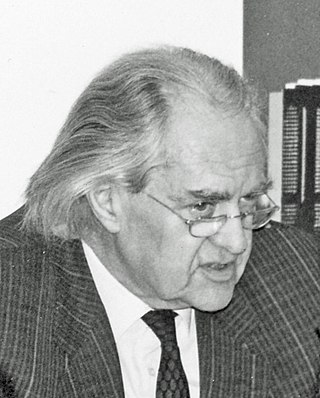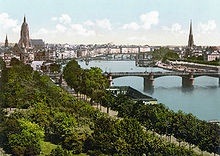
Frankfurt am Main is the most populous city in the German state of Hesse. Its 773,068 inhabitants as of 2022 make it the fifth-most populous city in Germany. Located in the foreland of the Taunus on its namesake Main, it forms a continuous conurbation with Offenbach am Main; its urban area has a population of over 2.7 million. The city is the heart of the larger Rhine-Main metropolitan region, which has a population of more than 5.8 million and is Germany's second-largest metropolitan region after the Rhine-Ruhr region and the fourth biggest metropolitan region by GDP in the European Union. Frankfurt is one of the de facto four main capitals of the European Union, as it is home to the European Central Bank, one of the institutional seats of the European Union, while Frankfurt's central business district lies about 90 km (56 mi) northwest of the geographic center of the EU at Gadheim in Lower Franconia. Like France and Franconia, the city is named after the Franks. Frankfurt is the largest city in the Rhenish Franconian dialect area.

Höchst is a neighbourhood and market town in the Ortsbezirk of Frankfurt-West in Frankfurt am Main, Germany. Höchst is situated 10 kilometres (6.2 mi) west of Frankfurt city centre, on the north bank of the Main at the confluence with the River Nidda. Its old town is famous for around 400 timber framed houses.

The Frankfurt U-Bahn is a Stadtbahn (premetro) system serving Frankfurt, Germany. Together with the Rhine-Main S-Bahn and the tram network, it forms the backbone of the public transport system in Frankfurt. Its name derives from the German term for underground railway, Untergrundbahn. Since 1996, the U-Bahn has been owned and operated by Stadtwerke Verkehrsgesellschaft Frankfurt am Main (VGF), the public transport company of Frankfurt, and is part of the Rhein-Main-Verkehrsverbund (RMV) transport association. The licence contract is up to 31 December 2031 and is renewable. The contracting authority of VGF is the municipal transport company traffiQ.

The Städelschule, full name Hochschule für Bildende Künste–Städelschule, is a tertiary school of art in Frankfurt am Main, Germany. It accepts about 20 students each year from around 500 applicants, and has a total of approximately 150 students of visual arts; until 2020 there were also about 50 students of architecture. About 75% of the students are not from Germany, and courses are taught in English.

The Museum für Moderne Kunst, or short MMK, in Frankfurt, was founded in 1981 and opened to the public 6 June 1991. The museum was designed by the Viennese architect Hans Hollein. It is part of Frankfurt's Museumsufer . Because of its triangular shape, the MMK is popularly called the Tortenstück. Since 2018, Susanne Pfeffer has been director of the MMK.

Hilmar Hoffmann was a German stage and film director, cultural politician and academic lecturer. He founded the International Short Film Festival Oberhausen. He was for decades an influential city councillor in Frankfurt, where he initiated the Museumsufer of 15 museums, including the Jewish Museum Frankfurt. He was the president of the Goethe-Institut and taught at universities such as Bochum and Tel Aviv. He wrote the book Kultur für alle, which was a motto of his life and work.

Nida was an ancient Roman town in the area today occupied by the northwestern suburbs of Frankfurt am Main, Germany, specifically Frankfurt-Heddernheim, on the edge of the Wetterau region. At the time of the Roman empire, it was the capital of the Civitas Taunensium. The name of the settlement is known thanks to written sources from Roman times and probably derives from the name of the adjacent river Nidda.
The following is a timeline of the history of the German city of Leipzig.
The following is a timeline of the history of the city of Cologne, Germany.
The following is a timeline of the history of the city of Munich, Germany.
The following is a timeline of the history of the city of Stuttgart, Germany.
The following is a timeline of the history of the city of Bonn, North Rhine-Westphalia, Germany.
The following is a timeline of the history of the city of Hamburg, Germany.
The following is a timeline of the history of the municipality of Bern, Switzerland.
The following is a timeline of the history of the city of Mainz, Germany.
The following is a timeline of the history of the city of Münster, North Rhine-Westphalia, Germany.
The following is a timeline of the history of the city of Hanover, Germany.

The following is a timeline of the history of the city of Dortmund, Germany.
The following is a timeline of the history of the city of Kassel, Germany.
The following is a timeline of the history of the city of Salzburg, Austria.










